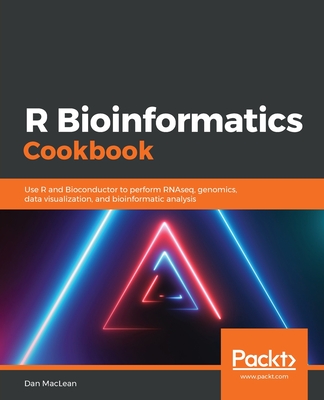R Bioinformatics Cookbook
Use R and Bioconductor to perform RNAseq, genomics, data visualization, and bioinformatic analysis
暫譯: R 生物資訊食譜
Dan MacLean
- 出版商: Packt Publishing
- 出版日期: 2019-10-11
- 售價: $2,130
- 貴賓價: 9.5 折 $2,024
- 語言: 英文
- 頁數: 316
- 裝訂: Paperback
- ISBN: 1789950694
- ISBN-13: 9781789950694
-
相關分類:
R 語言
-
其他版本:
R Bioinformatics Cookbook : Utilize R packages for bioinformatics, genomics, data science, and machine learning, 2/e (Paperback)
買這商品的人也買了...
商品描述
Key Features
- Apply modern R packages to handle biological data using real-world examples
- Represent biological data with advanced visualizations suitable for research and publications
- Handle real-world problems in bioinformatics such as next-generation sequencing, metagenomics, and automating analyses
Book Description
Handling biological data effectively requires an in-depth knowledge of machine learning techniques and computational skills, along with an understanding of how to use tools such as edgeR and DESeq. With the R Bioinformatics Cookbook, you'll explore all this and more, tackling common and not-so-common challenges in the bioinformatics domain using real-world examples.
This book will use a recipe-based approach to show you how to perform practical research and analysis in computational biology with R. You will learn how to effectively analyze your data with the latest tools in Bioconductor, ggplot, and tidyverse. The book will guide you through the essential tools in Bioconductor to help you understand and carry out protocols in RNAseq, phylogenetics, genomics, and sequence analysis. As you progress, you will get up to speed with how machine learning techniques can be used in the bioinformatics domain. You will gradually develop key computational skills such as creating reusable workflows in R Markdown and packages for code reuse.
By the end of this book, you'll have gained a solid understanding of the most important and widely used techniques in bioinformatic analysis and the tools you need to work with real biological data.
What you will learn
- Employ Bioconductor to determine differential expressions in RNAseq data
- Run SAMtools and develop pipelines to find single nucleotide polymorphisms (SNPs) and Indels
- Use ggplot to create and annotate a range of visualizations
- Query external databases with Ensembl to find functional genomics information
- Execute large-scale multiple sequence alignment with DECIPHER to perform comparative genomics
- Use d3.js and Plotly to create dynamic and interactive web graphics
- Use k-nearest neighbors, support vector machines and random forests to find groups and classify data
Who this book is for
This book is for bioinformaticians, data analysts, researchers, and R developers who want to address intermediate-to-advanced biological and bioinformatics problems by learning through a recipe-based approach. Working knowledge of R programming language and basic knowledge of bioinformatics are prerequisites.
商品描述(中文翻譯)
#### 主要特點
- 應用現代 R 套件處理生物數據,使用真實世界的範例
- 以適合研究和出版的先進視覺化方式表示生物數據
- 處理生物資訊學中的現實問題,如下一代測序、宏基因組學和自動化分析
#### 書籍描述
有效處理生物數據需要深入了解機器學習技術和計算技能,並理解如何使用如 edgeR 和 DESeq 等工具。透過《R 生物資訊學食譜》,您將探索這些內容以及更多,使用真實世界的範例來解決生物資訊學領域中的常見和不常見挑戰。
本書將採用基於食譜的方法,向您展示如何在計算生物學中使用 R 進行實用的研究和分析。您將學習如何使用 Bioconductor、ggplot 和 tidyverse 中的最新工具有效分析數據。本書將指導您了解 Bioconductor 中的基本工具,以幫助您理解和執行 RNAseq、系統發育學、基因組學和序列分析中的協議。隨著進展,您將了解機器學習技術如何應用於生物資訊學領域。您將逐步培養關鍵的計算技能,例如在 R Markdown 中創建可重用的工作流程和代碼重用的套件。
在本書結束時,您將對生物資訊分析中最重要和最廣泛使用的技術及處理真實生物數據所需的工具有扎實的理解。
#### 您將學到什麼
- 使用 Bioconductor 確定 RNAseq 數據中的差異表達
- 運行 SAMtools 並開發管道以查找單核苷酸多態性 (SNPs) 和插入缺失 (Indels)
- 使用 ggplot 創建和註解各種視覺化圖形
- 使用 Ensembl 查詢外部數據庫以查找功能基因組信息
- 使用 DECIPHER 執行大規模多序列比對以進行比較基因組學
- 使用 d3.js 和 Plotly 創建動態和互動的網頁圖形
- 使用 k 最近鄰、支持向量機和隨機森林來尋找群組和分類數據
#### 本書適合誰
本書適合生物資訊學家、數據分析師、研究人員和 R 開發者,旨在通過基於食譜的方法解決中級到高級的生物和生物資訊學問題。具備 R 程式語言的工作知識和基本的生物資訊學知識是前提條件。
作者簡介
Dan MacLean has a Ph.D. in molecular biology from the University of Cambridge and gained postdoctoral experience in genomics and bioinformatics at Stanford University in California. Dan is now a Honorary Professor in the School of Computing Sciences at the University of East Anglia. He has worked in bioinformatics and plant pathogenomics, specializing in R and Bioconductor and developing analytical workflows in bioinformatics, genomics, genetics, image analysis, and proteomics at The Sainsbury Laboratory since 2006. Dan has developed and published software packages in R, Ruby, and Python with over 100,000 downloads combined.
作者簡介(中文翻譯)
丹·麥克林(Dan MacLean)擁有劍橋大學的分子生物學博士學位,並在加州的史丹佛大學獲得基因組學和生物資訊學的博士後經驗。丹目前是東英吉利大學計算科學學院的名譽教授。自2006年以來,他在薩恩斯伯里實驗室從事生物資訊學和植物病原基因組學的工作,專注於R和Bioconductor,並開發生物資訊學、基因組學、遺傳學、影像分析和蛋白質組學的分析工作流程。丹已經開發並發佈了多個R、Ruby和Python的軟體包,總下載量超過100,000次。
目錄大綱
- Performing Quantitative RNAseq
- Finding Genetic Variants With Next-Generation Sequence Data
- Analyzing Gene and Protein Sequence For Domains and Motifs
- Phylogenetic Analysis and Visualisation
- Metagenomics
- Proteomics from Spectrum to Annotation
- Producing Publication and Web-Ready Visualizations
- Working with Databases and Remote Data Sources
- Useful Statistical and Machine Learning Methods in Bioinformatics
- Programming and Analysis with Tidyverse
- Building reusable workflows with packages and objects for code re-use
目錄大綱(中文翻譯)
- Performing Quantitative RNAseq
- Finding Genetic Variants With Next-Generation Sequence Data
- Analyzing Gene and Protein Sequence For Domains and Motifs
- Phylogenetic Analysis and Visualisation
- Metagenomics
- Proteomics from Spectrum to Annotation
- Producing Publication and Web-Ready Visualizations
- Working with Databases and Remote Data Sources
- Useful Statistical and Machine Learning Methods in Bioinformatics
- Programming and Analysis with Tidyverse
- Building reusable workflows with packages and objects for code re-use














